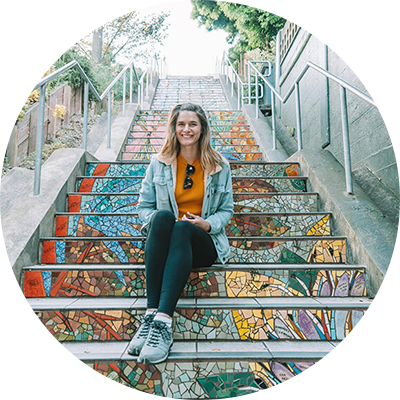From which routes to take, where to get on, and where to sit for the best views, this article has everything you need to know to ride cable cars in San Francisco.
San Francisco’s iconic cable cars not only transport people through the city but also through time–back to the city’s gold-rush origins.
Taking a cable car ride is a must-do experience that I always recommend to visitors.
Step onto a hand-crafted wooden car, and an underground cable steadily pulls you along the city streets through colorful neighborhoods to the waterfront.
Grab a seat outside for some incredible views. Or, if you’re brave, hold onto the pole for an urban rollercoaster ride!
Although San Francisco has plenty of high-tech transportation options available (watch out for those driverless cars!), cable cars are still one of the best — and most fun — ways to get up and down the steep streets of Nob Hill.
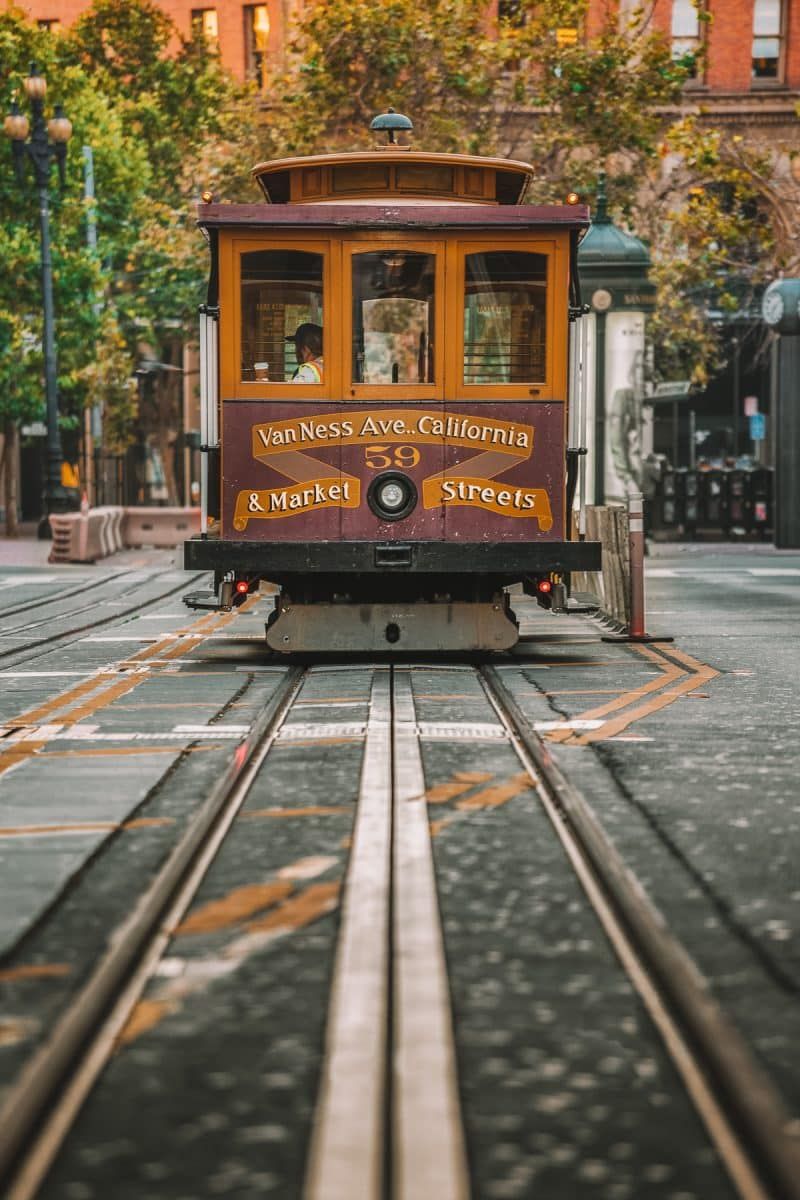
Get your FREE California Travel Planner – including printable checklists and my favorite two-week itinerary for the state.
Cable Car Map, Routes & Timetable
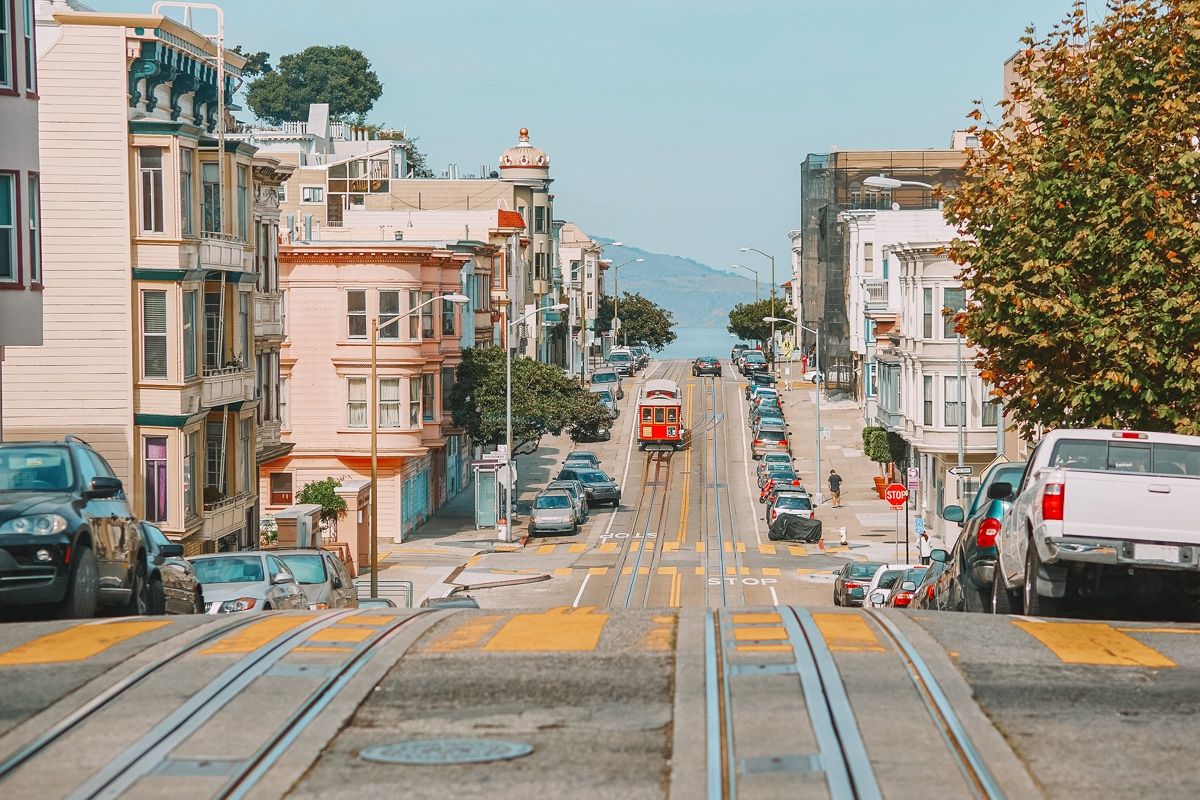
View route map here.
San Francisco has three cable car routes: Powell Hyde, Powell-Mason, and California Van Ness. Powell Hyde and Powell Mason run from downtown San Francisco to Fisherman’s Wharf.
In contrast, California Van Ness runs along California Street, through the Financial District, and into the leafy Nob Hill neighborhood.
Most people start their ride at the turnaround. It’s fun to watch the car spin around, plus starting your trip at the beginning of the line gives you the most bang for your buck. Union Square is a tourist hotspot, with shops, restaurants, and museums nearby.
Both Powell line routes follow the same line through downtown, splitting as they get closer to the northern end of San Francisco to terminate in different areas of Fisherman’s Wharf.
So if you’re trying to decide which cable car route to take, ride one line out and the other Powell route on your return.
The cable car schedule is straightforward: you’ll see a cable car every ten minutes, from 7 a.m. to 10.30 p.m. daily.
An important note: the cable cars are historical artifacts or accurate recreations of one. Unlike other MUNI transportation, cable cars are not wheelchair accessible, unfortunately.
Powell Hyde Cable Car
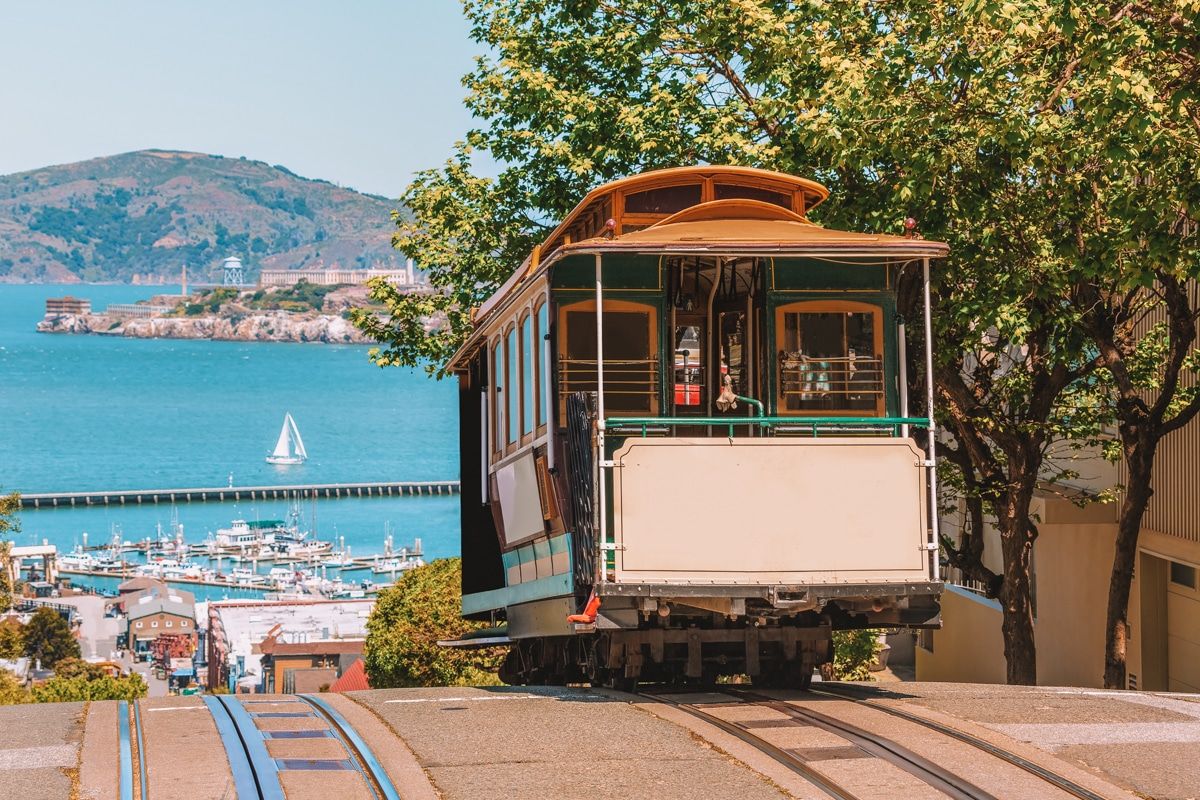
Powell Hyde starts at the Powell and Market cable car turnaround near Union Square and ends at Fisherman’s Wharf. The route is 2.1 miles long and takes about 20 minutes.
After departing Union Square, this cable car line takes passengers into the beautiful Russian Hill neighborhood, with its historic homes and steep hills.
If you’re looking for scenic views of the city, take this route from Union Square toward Fisherman’s Wharf.
The cable car pauses for a moment as it passes by the top of famous Lombard Street, known as the world’s most crooked street, so take this opportunity to grab a photo. Here you’ll get those fantastic views across the city and beyond, all the way to Alcatraz Island.
The Powell Hyde cable car line ends at Hyde and Beach Streets at the west end of Fisherman’s Wharf.
Nearby Ghirardelli Square offers delicious hot chocolate if you’re looking for somewhere to warm up after a chilly ride.
Follow the wharf to the east for Pier 39, where you can cut down Taylor Street to hop on a Powell Mason line for the return trip down Powell Street to Union Square.
Powell Mason Cable Car
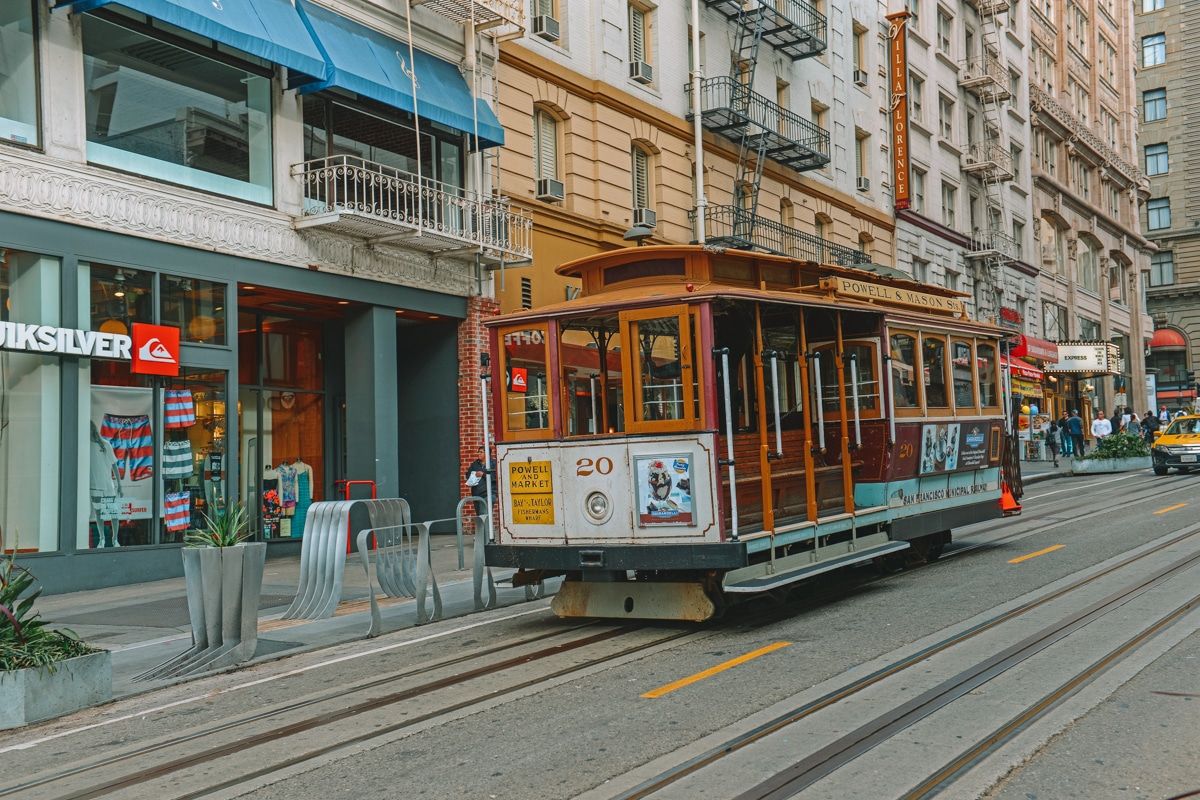
Powell Mason also starts at Powell and Market Street, ending at Taylor Street and Bay Street in the Fisherman’s Wharf neighborhood.
The route is 1.6 miles long and takes about 17 minutes to complete.
The Powell Mason line stops close to the bottom of famous Lombard Street, which is the best view of this street. This cable car ride takes you into the buzzy North Beach neighborhood, known for its vibrant Italian-American community.
This stop is an excellent place to hop off for a bite, eat in one of the neighborhood trattorias around Washington Square, grab a drink at Francis Ford Coppola’s Cafe Zoetrope, or check out the literary landmark, City Lights bookstore.
The Powell Mason cable car line ends at Taylor Street, where it drives onto the Bay & Taylor cable car turnaround for the return journey.
Confusingly, Bay Street is not adjacent to the bay – this is the old boundary of the city before landfill gained extra land from the water.
Head north three blocks, and you’ll hit the Fisherman’s Wharf area, where you’ll find tourist attractions at Pier 39.
Continue your San Francisco tour into the water with a bay cruise, or explore the ocean while staying on dry land with a trip to the Aquarium of the Bay.
Walk west along the water’s edge to Hyde Street Pier, where you can see the historic ships used by San Franciscans to cross over to Marin before the Golden Gate Bridge was constructed in 1937.
To return to Union Square, head south on Hyde Street toward Beach Street, where you’ll find the cable car turnaround for the Powell Hyde line.
California Van Ness Cable Car
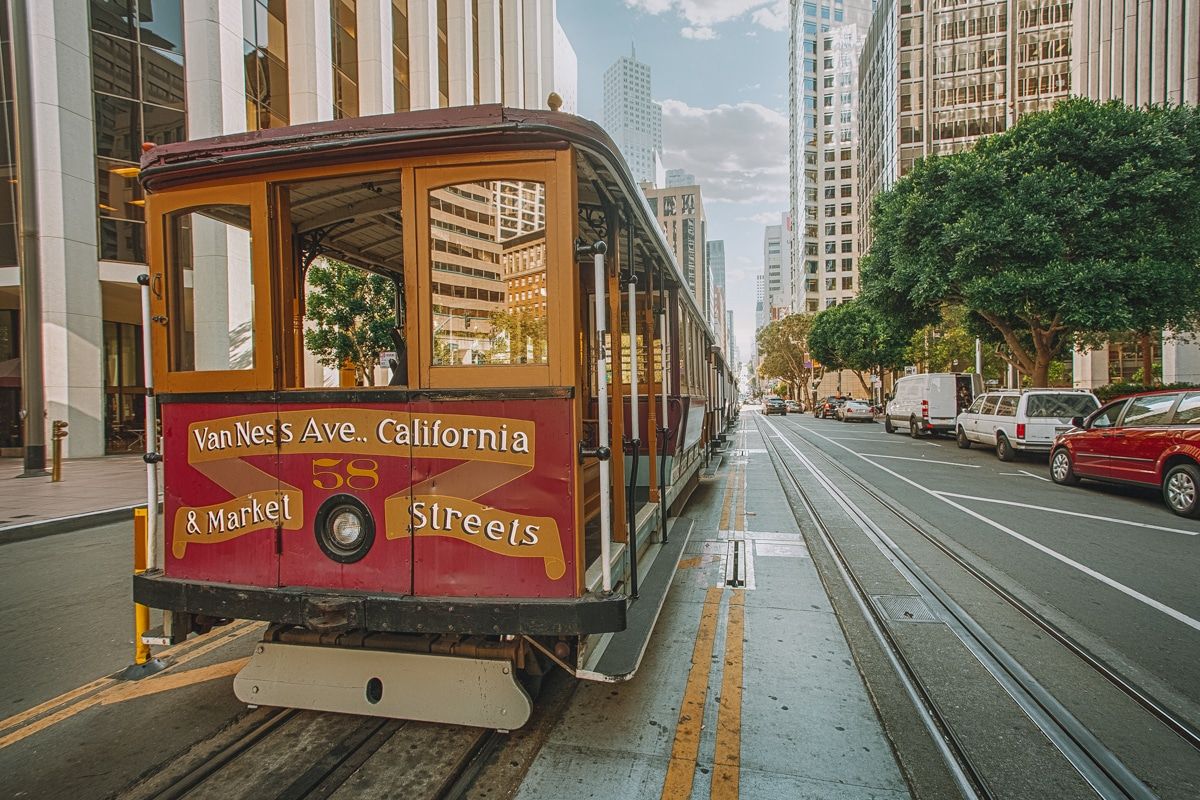
There are other cable cars besides the Powell lines.
Unlike the Powell lines, which run north-south, connecting downtown San Francisco to the Fisherman’s Wharf area, the California line starts at California and Market streets. It follows California Street on an east-west route.
The route is 1.4 miles long, taking about 16 minutes.
Starting near the Ferry Building, the SF cable cars glide through the Financial District and Chinatown, climbing up to Nob Hill and ending at Van Ness Avenue.
The California line is the least touristy of all three cable car lines. It’s popular with commuters, who use the historic streetcars for their original purpose of bringing in workers to the Financial District.
If you step off for a look around, the towering modern buildings contrast with the classic cars.
After emerging from the high-rise shaded streets of the business district, the cable cars continue up to the swanky neighborhood of Nob Hill.
Hop off to sip martinis at the Top of the Mark, the Intercontinental Hotel’s famous bar with fabulous views across San Francisco.
The California Street route also takes you through Chinatown, home to the biggest Chinese population outside of Asia.
I highly recommend taking a tour of the Golden Gate Fortune Cookie Factory to see how they make these little post-dinner treats.
California line cars do not need a turnaround, as they have double-ended cars. These more “modern” cable cars have outer sections at the front and back.
Cost to Ride the San Francisco Cable Car
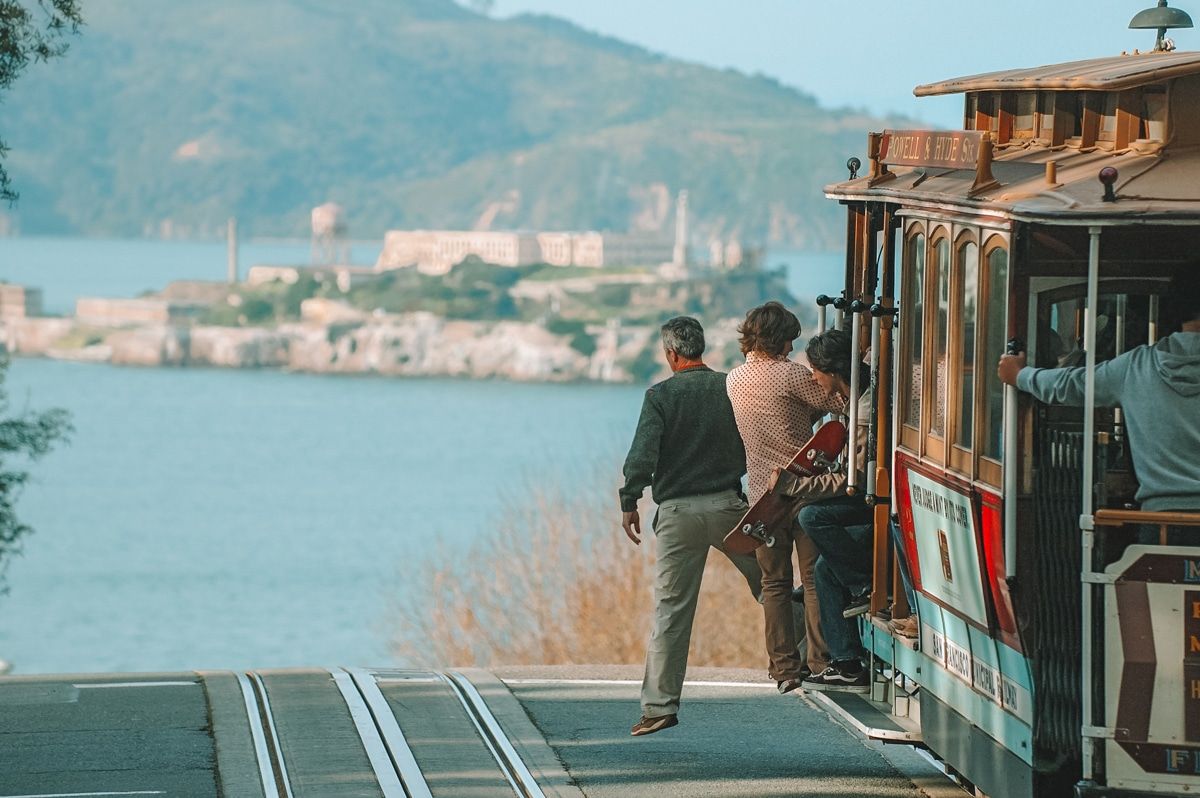
Cable car tickets cost $8 for a single ride, with under four-year-olds riding for free. Seniors, people with disabilities, and those on Medicare can ride for $4 from 9pm to 7am.
If you have exact change, you can pay the cable car fare collector after you are seated on board.
Otherwise, buy a ticket from one of the ticket booths located across the city. A Clipper Card will also work as payment on the San Francisco cable car system.
The cable car price gets you a single ride only, and that could be just a few stops if you want to get off to explore the Cable Car Museum or any of the other exciting landmarks along the route.
If you’re using public transport to get around San Francisco or want to ride more than once, it makes sense to buy a One Day Visitor Passport for $13 instead.
These passes offer unlimited rides on all Muni transport, including the historic cable cars. Multi-day passes are also available.
Download the MuniMobile app to buy a visitor pass. If you don’t have a smartphone, you can buy a pass from a kiosk at a higher price of $26.
How to Ride the Cable Cars in San Francisco
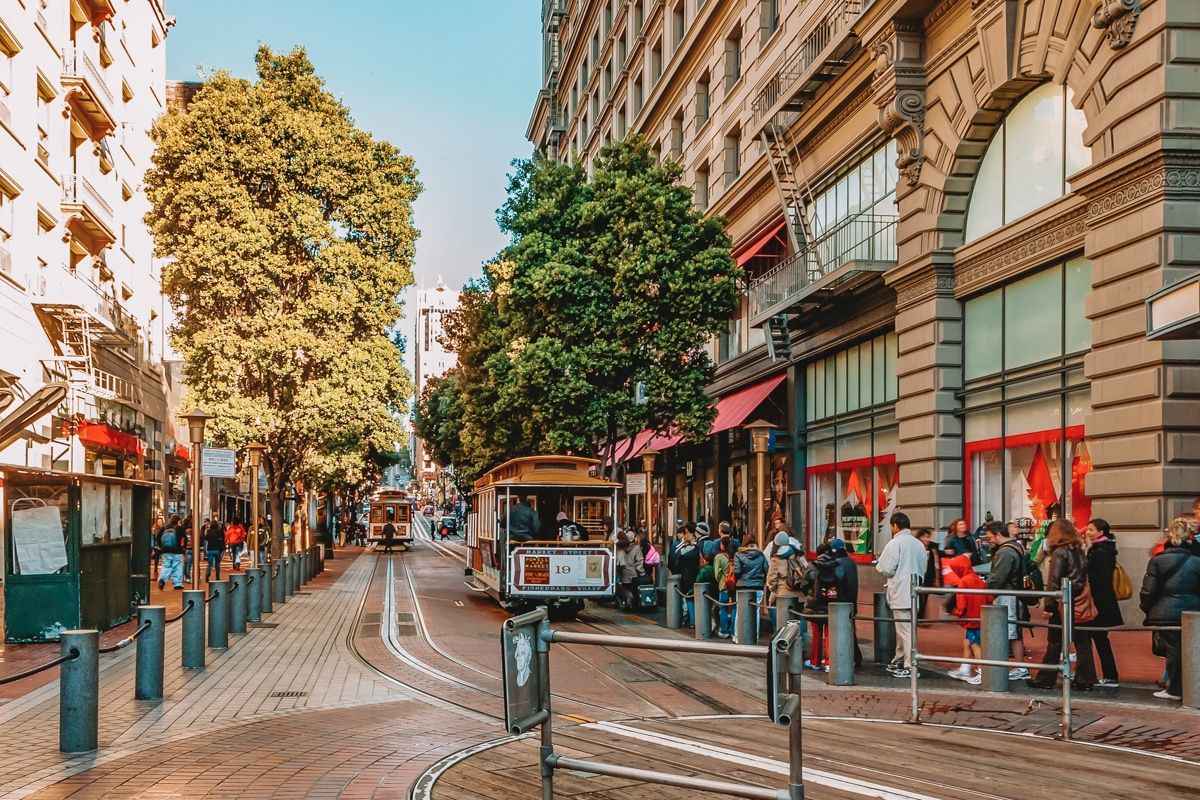
Getting on the Cable Car
Most people get on at the cable car turnarounds and exit at the other end of the cable car lines, which makes sense because you’re getting the longest possible trip this way.
However, this also means waiting in line during busy periods. You can avoid lines by walking to the next stop, but you may not get the best spot.
If you’re keen to get a good seat, it’s worth waiting at the turnaround and letting a few people in line behind you go first so you’re first in line for the next car.
Don’t forget; you can also board on the other side of the cable car. Hustle, and you can grab a great seat even if you’re not first in line.
It’s also important to remember that if you’re paying with cash, you’ll need to have exact change.
Cable car stops along the routes are clearly marked with a brown and white sign that says MUNI Cable Car Stop. Wait by the sign and wave to signal the driver that you want to get on when you see the car approaching.
Where to sit on the Cable Car
There are outside and inside seats or poles to stand up and hold. The outside seats usually go first, as they offer the best views. Bring an extra layer; it can get cold in San Francisco!
For the best views on the Powell Hyde line, sit on the right side on the way to Fisherman’s Wharf or the left if you’re heading back to Union Square.
Personally, I think the best seat is not a seat at all, but the standing area by the poles. It’s a lot of fun coasting down hills and zipping round corners as you hang on tight, wind in your hair, traffic inches away.
How to get off the Cable Car
Most people get off at the cable car turnarounds, where they stop to let everybody off.
If you want to hop off at another point on the route, simply say “Next stop, please” to the driver about half a block before you want to leave.
Be careful getting off at the stops, as you will be stepping into traffic. Disembarking at the turnarounds is the safest option.
Tips for Riding San Francisco Cable Cars
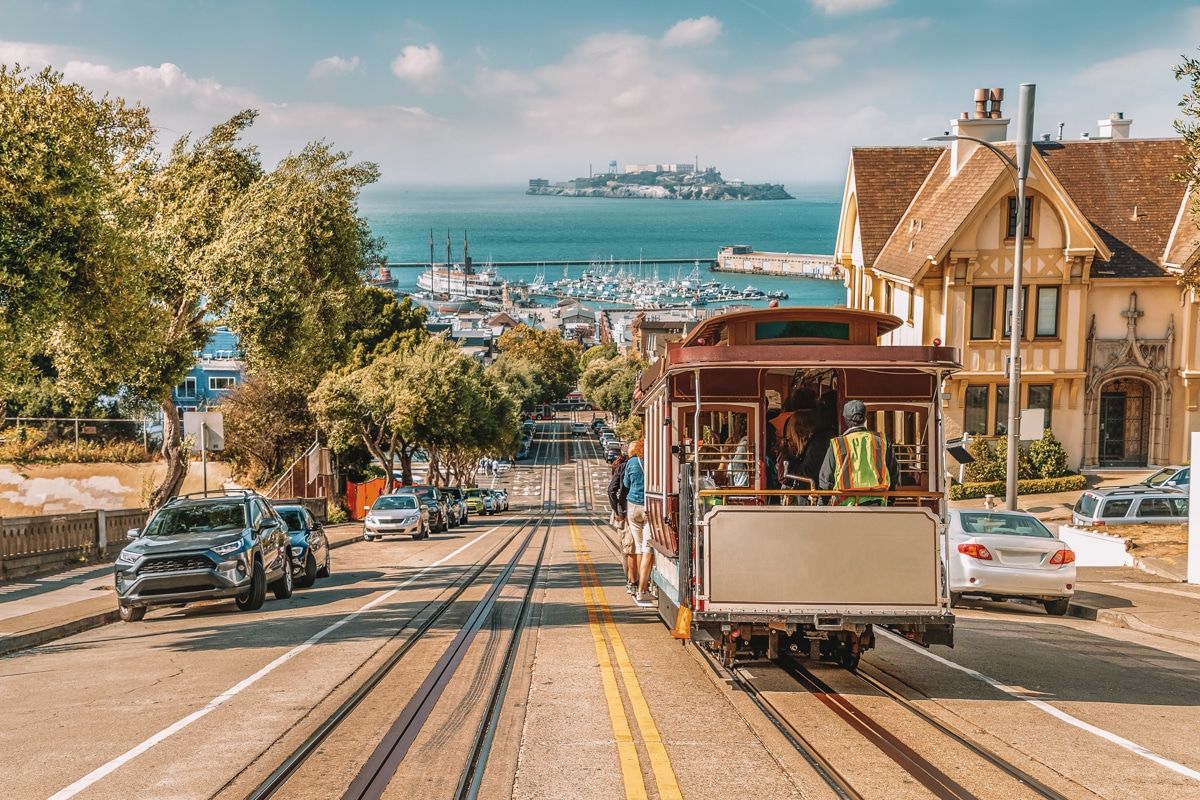
- Skip long lines at the Market Street turnaround by waiting instead at the O’Farrell Street and Powell Street stop. Drivers leave a few seats empty at the cable car turnarounds so passengers can get on at later stops.
- Lines are generally shorter for the California line turnaround at California and Market streets, so take this route if you don’t have time to wait.
- The Powell Hyde route has the best views but also the longest lines. Go between 9 and 10a.m to avoid a long wait.
- If you took the Powell Hyde line to Fisherman’s Wharf, ride the Powell Mason route back – the line is shorter, and you’ll go through a different neighborhood.
- It’s a lot of fun to stand on the outside step holding onto the pole, especially when coasting down the steep streets. Just don’t let go!
Fun Facts About San Francisco’s Cable Cars
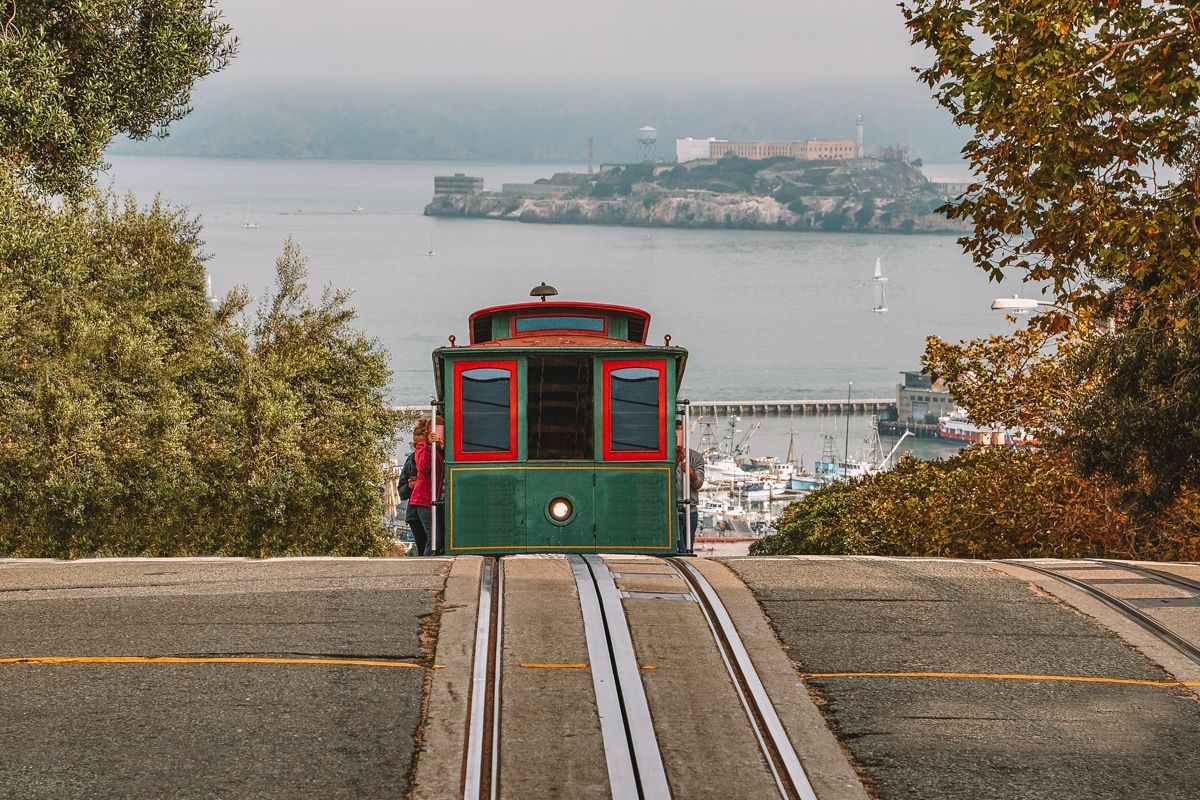
- San Francisco cable cars are a unique National Historic Landmark, the only one that moves.
- Poet and civil rights activist Maya Angelou was a San Francisco cable car conductor in World War II.
- New cable cars, hand-built by skilled carpenters, take around two years to complete.
- In addition to the historic cable cars, San Francisco also has traditional streetcars, which run along the Embarcadero.
- Two people operate San Francisco cable cars: a conductor and a gripman. The gripman has a difficult job, requiring perfect timing and upper body strength to handle the cable pulling the car.
- A bell-ringing contest among cable car operators is held annually in Union Square. Conductors and gripmen compete for glory in a popular event that draws huge crowds.
History of the San Francisco Cable Car
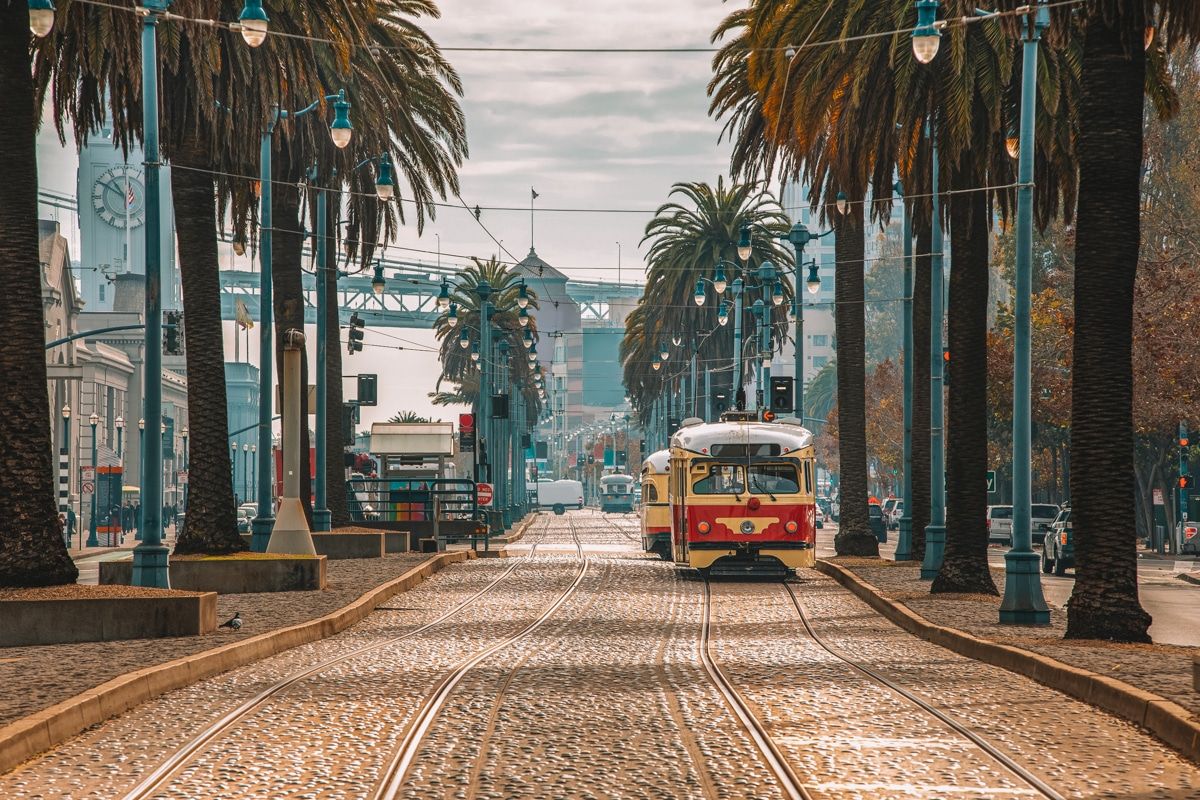
San Francisco has a unique topography, creating a unique problem. The many hills scattered across the city’s seven square miles are so steep that the transportation system of the 1870s (horse and cart) was sadly underpowered.
Seeing the poor animals struggle to drag heavy loads through the city streets, inventor Andrew Smith Hallidie devised an innovative solution: a cable-driven rail system based on mining technology.
Members of the public boarded the first cable cars in August 1873.
The San Francisco cable car system was hugely popular, and at its peak, there were 53 miles of track across the city, connecting neighborhoods with the Ferry Building, Golden Gate Park, and the Presidio.
In 1888, electric streetcars came on the scene, and cheaper technology replaced cable cars in San Francisco as a standard San Francisco convention.
The 1906 earthquake and subsequent fires also damaged the cable car system, including the cable car barn that housed the vehicles.
By 1947, the city proposed shutting down the last three lines. Fortunately, San Francisco cable car fans launched a successful campaign to save the iconic cable cars, recognizing that cable car rides are an essential part of the city’s heritage.
Today, only three lines remain, but they take millions of tourists and commuters to their destinations across the city every day.
Today, the restored cable car barn does double duty as a repair shop and as the site of the Cable Car Museum.
Ultimately, Hallidie’s San Francisco cable cars survived earthquakes, wars, and new technology to become an enduring icon of this Bay Area city well into the 21st century.
Visit the Cable Car Museum to Learn More
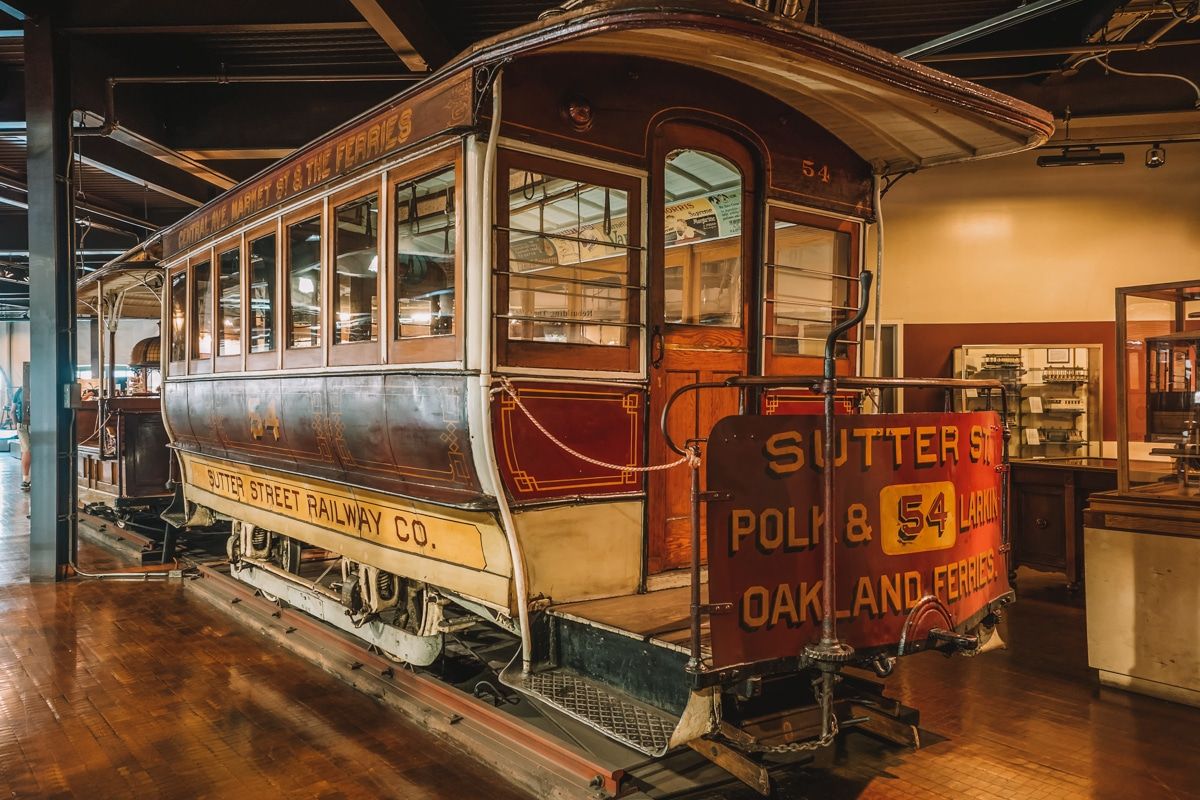
The Cable Car Museum is one of the most unique San Francisco Museums. The Powell line runs by the Cable Car Museum, in the Washington-Mason power house, and the cable car barn on Nob Hill at the corner of Mason Street and Washington Street.
The museum is free and showcases old cable cars plus other exhibits. You can also see the enormous winding wheels that move the underground cables and the engines that power them.
It’s an excellent opportunity to find out more about the history of the San Francisco cable car.
FAQs About San Francisco Cable Cars
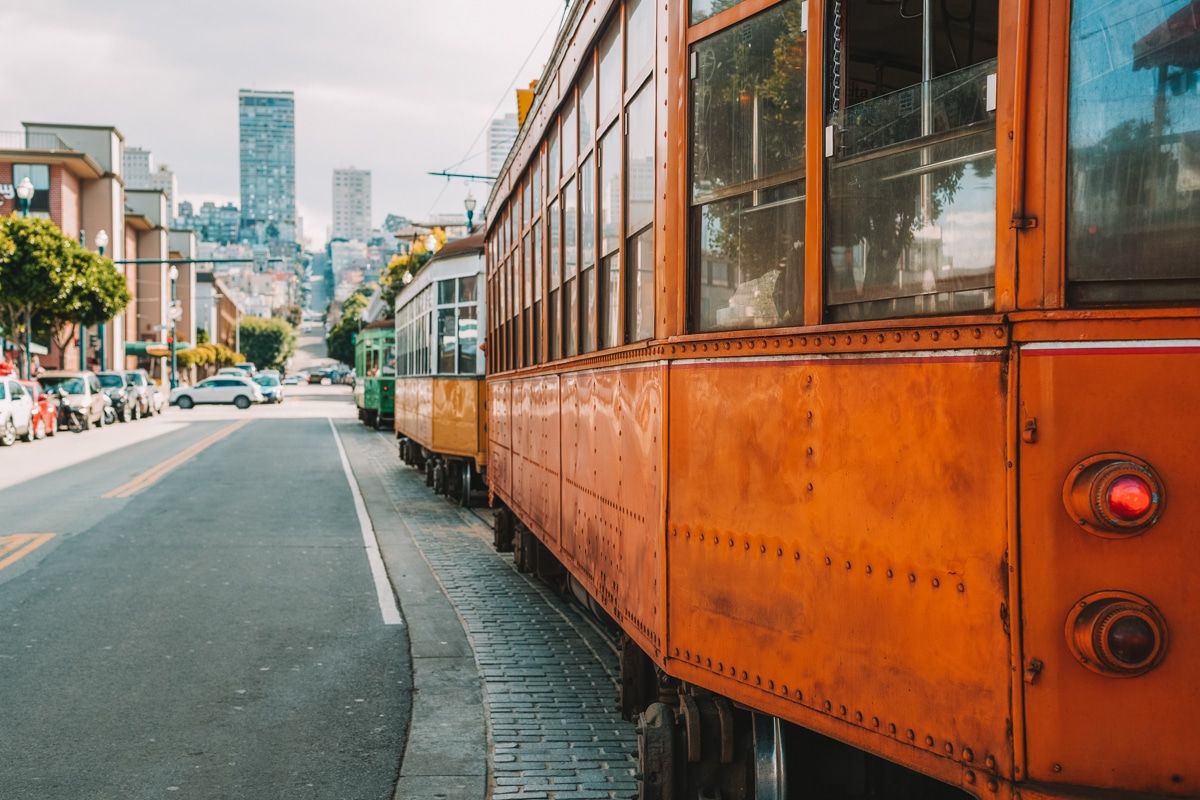
Which cable car route is best in San Francisco?
Many consider the Powell Hyde line the best cable car route of the three lines in San Francisco, which runs from the corner of Powell and Market Streets to the end of Hyde Street at the waterfront.
Cars on this line diverge from the Powell Mason line at Jackson Street, taking a steep route through the famous hills of San Francisco.
Riding a cable car on this line gives passengers superb views across the city and a thrilling ride down one of the steepest hills in San Francisco.
Because of its popularity, expect long lines at the Market Street stop, especially in the summer.
Arrive early at 9 a.m., or consider one of the other lines, like the California St line.
Are cable cars currently operating in San Francisco?
After a 16-month shutdown during the pandemic, the cable cars are back in service. Cable car hours are 7 a.m. to 10:30 p.m. daily.
How many cable car routes are there in San Francisco?
Three cable car lines remained after a successful campaign in the 1950s to preserve cable cars as a tourist attraction.
The Powell Hyde line and Powell Mason line depart from the corner of Market Street and Powell Street, ending in different areas of Fisherman’s Wharf.
The California Street cable cars run between the Ferry Building and Van Ness Avenue in Russian Hill.
Do Clipper cards work on cable cars?
Yes, Clipper Cards do work to ride the cable cars. If you have a monthly transit pass, riding the cable cars is included along with all other MUNI transportation options.
You can buy a Clipper Card for $3 at one of the ticket booths, where you can also load cash onto the card.
If you are a visitor, a one, three, or seven-day Visitor Passport offers better value for money if you plan on riding a cable car more than once.
Do cable cars go down Lombard Street?
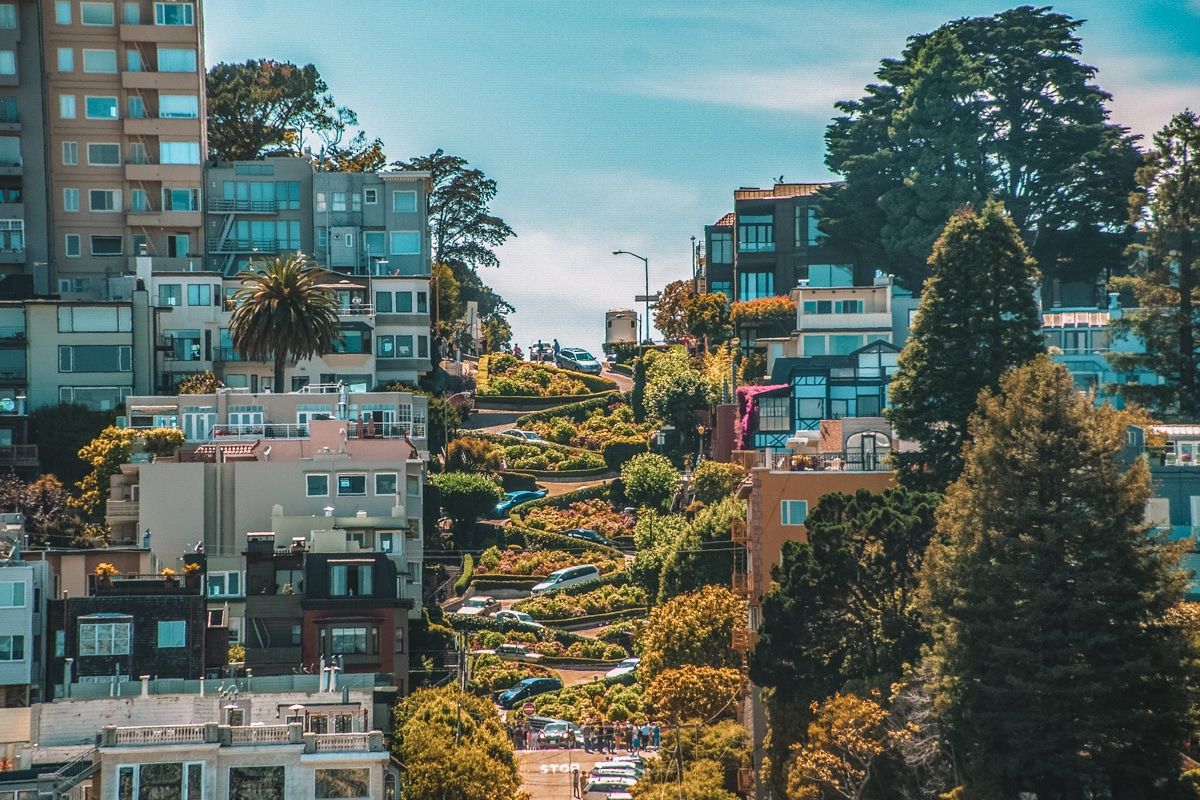
The cable cars do not wind down Lombard Street itself, but they pass by at the top and the bottom of the famous street.
If you want to walk down Lombard Street (preferable to walking up the notoriously steep road), take the Powell Hyde line from the corner of Powell and Market Streets, then disembark at the Lombard Street stop.
Walk down the steps, then continue your journey to Fisherman’s Wharf by getting on the Powell Mason line, which stops at the bottom of Lombard Street.
Are San Francisco Street cars and cable cars the same?
These two modes of transportation are different, and you can ride both in San Francisco.
Street cars, which eventually replaced most cable car lines, are propelled by overhead electrical lines along rails on the street.
Cable cars are a uniquely San Francisco invention devised for the steep hills. A steel cable running below the street connects to the car above through a device controlled by the cable car operator, or “gripman,” driving the car.
You can ride a historic streetcar on the F line, which runs along the Embarcadero on San Francisco’s waterfront.
Other terms for street cars are the San Francisco trolley or tram.
How do Cable Cars Work?
San Francisco’s cable cars appear to glide along the streets without any apparent means of power. The secret hides under the tracks: a steel cable snakes through a channel below the rails.
Each cable car has a grip, a device that holds the cable, enabling the cable to pull the vehicle along the streets at a constant speed of 9.5 miles per hour.
When the cable cars pass over another set of rails, the grip must disengage to avoid slicing through the tracks. The car coasts through the gap, and the grip is engaged again on the other side.
This maneuver is all performed by a cable car operator, a gripman. It’s a highly skilled job that requires perfect timing.
You can learn more about how the cable car system works in the Washington and Mason Streets Cable Car Museum.
ABOUT THE AUTHOR
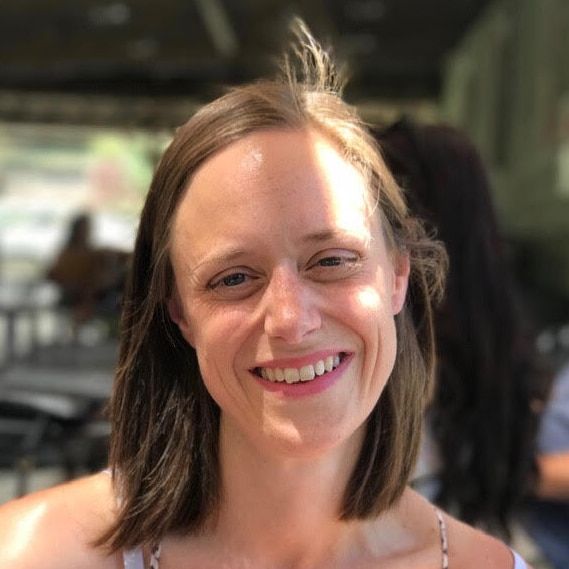
Sarah McDonald
Sarah McDonald is a travel writer based in the Bay Area. She writes for the national parenting website Red Tricycle and on her own family travel blog, Tiny Trailblazers. She loves exploring California’s outdoors and has a weakness for a national park gift shop.
Sarah enjoys sharing her Bay Area expertise with readers curious to try popular restaurants and off-the-beaten-path adventures in California. When she’s not writing reviews and travel guides, you’ll likely find her trying to keep up with her kids on a hiking trail or deciphering the menu at a new restaurant.
Looking for more San Francisco travel tips? Check out these related articles below!
Best Hikes in San Francisco, California
Best Thrift Stores in San Francisco for Second-Hand Gems
Best Pizza Places in San Francisco
Best Weekend Trips From San Francisco
Things to do in San Francisco at Night
Best Golden Gate Bridge Viewpoints
Walking the Golden Gate Bridge
Where to See Redwoods Near San Francisco
Outdoor Date Ideas in the Bay Area
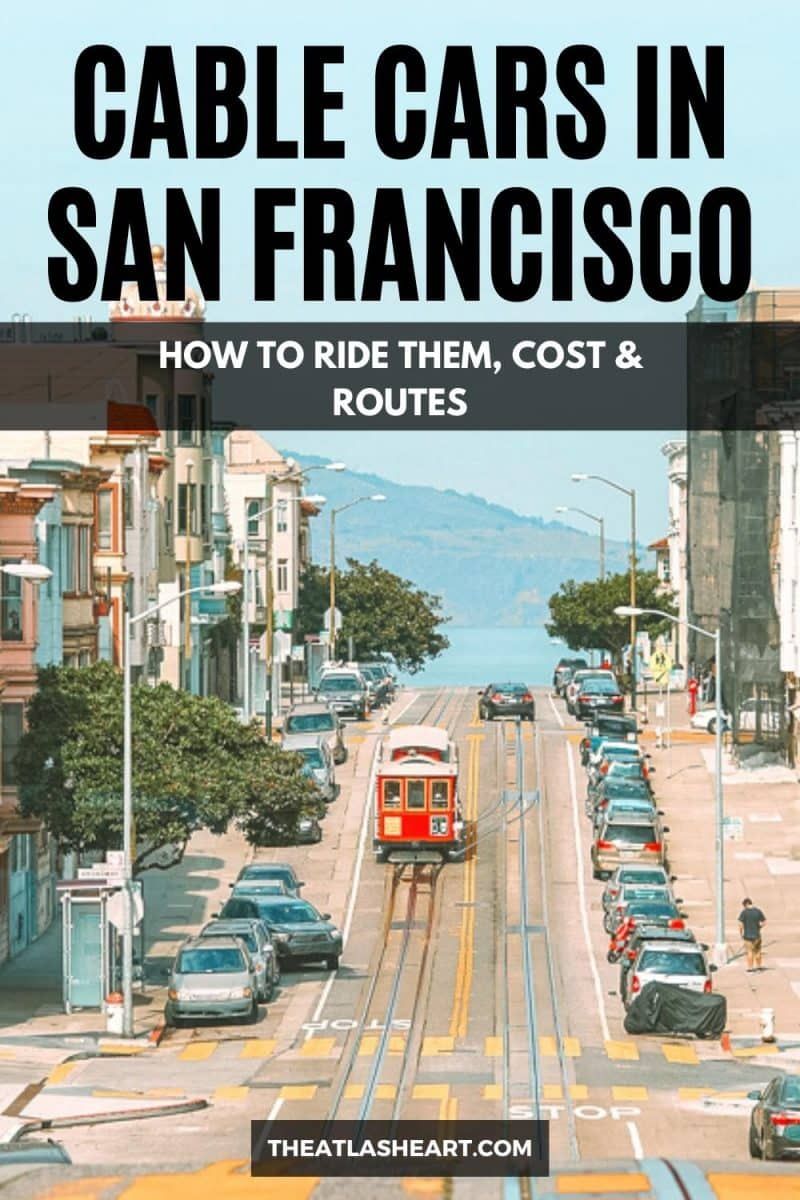
Pin this image for future reference

